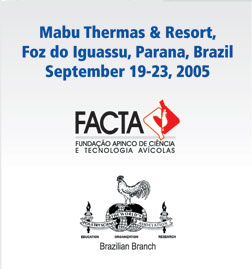ANTICOCCIDIAL SENSITIVITY PROFILE OF COCCIDIAL STRAINS
IN INOVOCOX™
A. Martin, R. M. Poston, G. F. Mathis2,
J. E. Hutchins, J. R. Upton, and V. W. Doelling
1Embrex Inc., P. O. Box 13989, Research Triangle Park,
NC 27709
2Southern Poultry Research, Athens, GA 30607
amartin@embrex.com
These
studies were conducted to determine the anticoccidial
sensitivity profiles of the vaccine strains comprising
Inovocox™. This live vaccine is delivered in
ovo to late stage embryos, and is composed of Eimeria
acervulina, E. tenella, and two strains of E. maxima.
Two studies were conducted. Broiler chicks were placed
in cages and fed unmedicated diet until 12 days of
age. Two cages were then assigned to each treatment
group as follows: Non-medicated non-challenged, non-medicated
challenged, salinomycin (SAL), monensin (MON), nicarbazin
(NIC), or diclazuril (DIC). After two days on the
medicated diets, chicks were challenged with oocysts.
Intestinal lesions and body weight gain were assessed
6 days later. E. acervulina and E. tenella were sensitive
to all anticoccidials tested, as demonstrated by both
lesion scores and body weight gain. Mild lesions were
evident in some birds medicated with DIC. This anticoccidial
primarily affects the sexual development of E. maxima
after the point of lesion development, so mild lesions
are not unexpected in drug sensitive strains. Improved
weight gain in the birds on DIC treatment indicated
sensitivity of both E. maxima strains. The chicks
medicated with SAL, MON, or NIC and challenged with
either of the two E. maxima strains had no significant
lesions. Both E. maxima strains were sensitive to
all of the anticoccidials as determined by body weight
gain. These studies demonstrate that all four vaccine
strains comprising Inovocox are sensitive to the most
commonly used anticoccidials.
